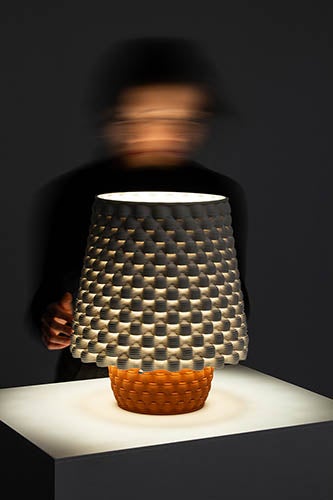Grading Light: Utilizing plastic deformation to functionally grade ceramic light screens

When interacting with light, surface geometries and clay bodies can work together to heighten the perception of depth and alter illumination. This thesis investigates how 3D clay printing can generate materially responsive engagements between ceramics and light. A computational methodology is developed to produce texture and sculptural relief in ceramic surfaces. Liquid Deposition Modelling is used to study the plastic deformation of clay during wet-processing. Most 3D printing technologies are currently conceived as end-stage production processes characterized by high-fidelity between digital models and physical outputs. Stoneware and porcelain have a wide variety of working properties and ceramic traits that demand new approaches to digital tooling. By making the study of material behaviour essential to the design process, clay 3D printing enables non-linear design-to-production systems. The research outputs are a series of stoneware and porcelain screens that vary in brightness and illumination based on how light may be obstructed, reflected or transmitted across their surfaces. Prototypes are developed at full scale to understand the relationship between sensory engagement and material properties. The scope, context and research methods are divided into three parts: Light and Ceramic Material Performance- explains stoneware and porcelain’s performance capabilities in the context of Functionally Graded Additive Manufacturing. Ceramics and Digital Fabrication- explains the tools by which the research methods are produced in the context of how tool path design is being leveraged in the practice of digitally crafted ceramics. Methodology- outlines the methods involved in making qualitative changes to alter light-scattering behaviour in 3D printed clay screens. The research is structured around a series of four light screen typologies. Each typology utilizes unique digital and physical tooling methods, harnesses plastic deformation, structural capabilities and light scattering behaviour in porcelain and stoneware structures.
The
examining
committee
is
as
follows:
Supervisor:
David
Correa
Committee
member:
Maya
Przybylski
Internal-external
reader
(UW
faculty
only):
John
McMinn
External
(non-UW
reviewers
only):
Ulrich
Knaack
The
defence
examination
will
take
place:
Tuesday,
Novemeber
30th,
2021,
1:30pm
Teams
link
available
via
the graduate
student
Learn
page
or
by
request.
The
committee
has
been
approved
as
authorized
by
the
Graduate
Studies
Committee.
A
copy
of
the
thesis
is
available
for
perusal
in
ARC
2106A.